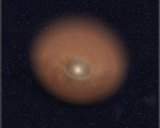
Using a new image-processing technique, the researchers obtained near-infrared scattered light photos of five disks observed around young stars in the database of the Mikulski Archive for Space Telescopes. These disks are telltale evidence of newly formed planets.
If astronomers initially miss something in their data review, they can still make discoveries by revisiting earlier data with new image-processing techniques, thanks to the wealth of information in the Hubble data archive. That is what Rémi Soummer, of the Space Telescope Science Institute in Baltimore, and his team recently did while on a hunt for hidden Hubble treasures.
Taking advantage of improvements in image processing, including algorithms used for face-recognition software, Soummer and his team reanalyzed the archived images, and they could unequivocally see the debris disks and even determine their shapes.
The dust in the disks is hypothesized to be produced by collisions between small planetary bodies such as asteroids. The debris disks are composed of dust particles formed from these grinding collisions. The tiniest particles are constantly blown outward by radiation pressure from the star. That means they must be replenished continuously though more collisions. This game of bumper cars was common in the solar system 4.5 billion years ago. Earth's moon and the satellite system around Pluto are considered to be collisional byproducts.
AFRICAN RAINFOREST IN DECLINE: A new analysis of NASA satellite data shows Africa's Congo rainforest, the second-largest tropical rainforest in the world, has undergone a large-scale decline in greenness over the past decade.
The study, led by Liming Zhou of the University at Albany, State University of New York, shows between 2000 and 2012 the decline affected an increasing amount of forest area. The research, published in the journal Nature, is one of the most comprehensive observational studies to explore the effects of long-term drought on the Congo rainforest using several independent satellite sensors.
The satellite-derived "greenness" of forest regions is one indicator of a forest's health. While this study looks specifically at the impact of a persistent drought in the Congo region since 2000, researchers say a continued drying trend might alter the composition and structure of the Congo rainforest, affecting its biodiversity and carbon storage.
Like us on Facebook and tell us what you think.
Related:
NASA In Brief -- Astronauts remembered; public invited to help find planets